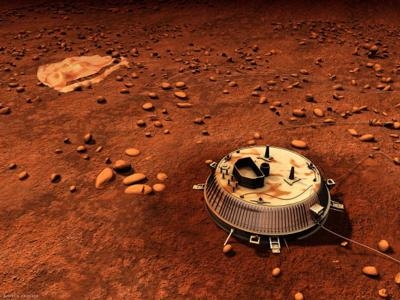Fri, Jan 16, 2015
Probe Was Able To Transmit Data For Only An Hour Before Batteries Were Drained
Ten years ago, an explorer from Earth parachuted into the haze of an alien moon toward an uncertain fate. After a gentle descent lasting more than two hours, it landed with a thud on a frigid floodplain, surrounded by icy cobblestones. With this feat, the Huygens probe accomplished humanity's first landing on a moon in the outer solar system. Huygens was safely on Titan, the largest moon of Saturn.

The hardy probe not only survived the descent and landing, but continued to transmit data for more than an hour on the frigid surface of Titan, until its batteries were drained.
Since that historic moment, scientists from around the world have pored over volumes of data about Titan, sent to Earth by Huygens -- a project of the European Space Agency -- and its mothership, NASA's Cassini spacecraft. In the past 10 years, data from the dynamic spacecraft duo have revealed many details of a surprisingly Earth-like world.
In addition to the technical wizardry needed to pull off this tour de force, international partnerships were critical to successfully delivering the two spacecraft to Saturn and Titan.
"A mission of this ambitious scale represents a triumph in international collaboration,” said Earl Maize, Cassini Project manager at NASA's Jet Propulsion Laboratory in Pasadena, California.
"From the mission's formal beginning in 1982, to Huygens' spectacular landing 23 years later, to the present day, Cassini-Huygens owes much of its success to the tremendous synergy and cooperation between more than a dozen countries. This teamwork is still a major strength of the project as the Cassini orbiter continues to explore the Saturn system," Maize said.
Cassini's mission is slated to continue through September 2017.
(Image provided by NASA)
More News
Also: Netherlands Donates 18 F16s, 2 737s Collide On Ramp, E-7 Wedgetail Cut, AgEagle's 100th In S Korea The Pilot and Aircraft Privacy Act was introduced in the House by Represent>[...]
Pilot Also Reported That Due To A Fuel Leak, The Auxiliary Fuel Tanks Were Not Used On June 4, 2025, at 13:41 eastern daylight time, a Piper PA-23, N2109P, was substantially damage>[...]
Have A Story That NEEDS To Be Featured On Aero-News? Here’s How To Submit A Story To Our Team Some of the greatest new stories ANN has ever covered have been submitted by our>[...]
From 2023 (YouTube Edition): Reflections on War’s Collective Lessons and Cyclical Nature The exigencies of war ought be colorblind. Inane social-constructs the likes of racis>[...]
What Goes Around, May Yet Come Back Around, Klyde FMI: www.klydemorris.com>[...]
 Airborne 06.30.25: US v ADS-B Misuse, Natl STOL Fire, Volocopter Resumes
Airborne 06.30.25: US v ADS-B Misuse, Natl STOL Fire, Volocopter Resumes NTSB Prelim: Piper PA-23
NTSB Prelim: Piper PA-23 ANN FAQ: Submit a News Story!
ANN FAQ: Submit a News Story! Classic Aero-TV: One Mans Vietnam
Classic Aero-TV: One Mans Vietnam Klyde Morris (06.30.25)
Klyde Morris (06.30.25)



